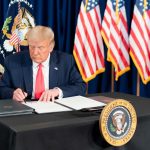President Trump has once again proven he’s not afraid to shake things up while keeping American interests at the forefront. In a bold move from the Oval Office, he announced a hefty 25 percent tariff on all automobiles not manufactured in the United States. Dubbed a “modest” tweak by the Trump administration, this decision speaks volumes about prioritizing American labor and manufacturing. The president made it clear that domestically produced cars will enjoy a free ride — no tariffs allowed.
The announcement follows a long history of watching foreign imports flood the American market, undermining the automotive industry that once thrived. The president’s approach addresses this issue head-on by bumping the previous base tariff from a mere 2.5 percent to a much more substantial 25 percent. It seems that businesses are finally getting the hint to bring jobs back home. Trump’s keen insight into this “massive story” indicates a growing trend where companies, tired of paying outrageous tariffs, are choosing to relocate their manufacturing processes right here in America.
The simplicity of the proposed tariff structure was emphasized in Trump’s remarks, as he touted the ease of a single tariff rate—no fluctuating numbers depending on car costs. Simple, straightforward, and utterly effective, this strategy aims to streamline the American automotive market and eliminate the insanity of cars being juggled between borders. After all, does it really make sense for a car to be manufactured in one place, assembled in another, and eventually sold in the U.S.? The answer, unsurprisingly, is no—just another “ridiculous” aspect of our globalized economy that needs reevaluation.
Trump Announces Tariffs on Car Imports https://t.co/VdXacfN8rY
— Fearless45 (@Fearless45Trump) March 26, 2025
Moreover, the president outlined how these tariffs will not only foster American production but will also help address the national debt. By establishing a basic, dependable taxation model on foreign vehicles, Trump envisions a future where the revenue can be funneled into reducing taxes and financing domestic projects—essentially getting the American economy back on an upward trajectory.
His comments also hinted at broader plans involving pharmaceuticals and a potential shift in the approach to China, with thoughts on easing certain tariffs to compel TikTok’s sale. If the automotive tariffs are any indication, this could be just the beginning of a wider strategy to reposition manufacturing within the U.S. With foreign industries receiving backing from government subsidies and aggressive policies, it’s high time to turn the tide and revive the American automotive sector.
In sum, President Trump’s new tariff plan is not just a financial maneuver; it’s a rallying cry for American resurgence. With such a decisive step, he demonstrates a commitment to fostering domestic production, safeguarding American jobs, and ensuring that the U.S. remains a leader in innovation and manufacturing. While the radical left might squawk over these measures, the push for American automotive dominance has never been stronger.




